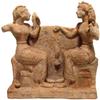Apollo Art Auctions’ July 24 sale features magnificent antiquities, ancient and Asian art
- LONDON, United Kingdom
- /
- July 14, 2022
LONDON – A museum-quality selection of expertly appraised antiquities, ancient and Asian artworks, jewellery and weaponry will be offered by Apollo Art Auctions on Sunday, July 24, starting at 12 noon BST (7 a.m US Eastern Time). The 500-lot sale will be conducted live at Apollo’s elegant London gallery, with international participation cordially welcomed via phone, absentee bid, or live online through LiveAuctioneers.
The sale is divided into four sections encompassing a broad range of well provenanced artifacts from Europe, Egypt and the Near East, as well as many prized items from India and China. Bidders may choose from a wealth of unique treasures with provenance from such noted collections such as those of Captain Magnus Julius Davidsen, Alison Barker, and John Lee – all names of great distinction in the realm of antiquities. Each and every piece chosen for the auction has been vetted by a team of world-renowned ancient art experts, including Laetitia Delaloye, Emma Saber, James Brenchley, Sami Fortune, and Apollo Art Auctions’ founder, Dr Ivan Bonchev (PhD, University of Oxford).
An artifact that goes back to the beginning of written language, a Sumerian pictographic tablet dates to circa 3100-2900 B.C. The rectangular tablet has columns of etched cuneiform writing which serves as an administrative account of food supplies. Measuring 44.8mm by 68.4mm and weighing 62.44 grams, it is similar to an example in The Metropolitan Museum of Art. The pre-auction estimate is £4,000-£8,000 ($4,810-$9,620).
Several remarkable Egyptian relics will take the spotlight on auction day. A rare and most unusual khopesh “sickle sword,” circa 1550-1070 B.C., is 556mm long and weighs 790 grams. Its name “khopesh” may have been derived from a word meaning “leg of beef,” in reference to the blade’s distinctive, comparable shape. The fearsome weapon is similar to a sword appearing in the Y Yadin book The Art of Warfare in Biblical lands, and has provenance from the Alan Baidun collection of Ex Alan Aidun collection, Israel. It is accompanied by a professional historical report from Ancient Report Specialists and an Israel export license. Estimate: £45,000-£50,000 ($54,120-$60,135).
From Egypt’s New Kingdom period, circa 1550-1070 BC, a wood canopic jar is finely modeled in the form of a human-headed Imsety, one of the Four Sons of Horus and guardian of the liver. The jar displays three columns of carefully and beautifully engraved hieroglyphs enhanced with black pigment. Its inscription, in part, invokes an offering of “bread, oxen and fowl.” With a long and illustrious line of provenance that includes the collection of Captain Magnus Julius Davidsen (1877-1962), this impressive vessel carries an auction estimate of £7,500-£15,000 ($9,020-$18,040).
More than 80 lots of Ancient Greek, Byzantine and Hellenistic artifacts will be presented, including pottery, sculptures, gold jewellery, and weapons of war. The latter category features curiosities such as ceramic “Greek fire” hand grenades and coveted bronze helmets. A fine example of a circa-400 BC Chalcidian helmet was forged in one piece with high-arched eyebrows below a peaked, raised band, and with a teardrop-shape nose guard. Similar to example in The Walters Art Museum collection, it is estimated at £6,000-£9,000 ($7,215-$10,825). A second Chalcidian bronze helmet, with original armored-plate cheek guards, probably originated on the northern coast of the Black Sea, circa 400-300 BC. It has graced several European private collections since its acquisition in Germany in 1983 and will be offered with a £12,000-£24,000 ($14,430-$28,860) estimate. Each of the two helmets is accompanied by a professional historical report from Ancient Report Specialists.
With its exceptional beauty and unmistakable artistry, ancient Roman jewelry consistently rates as one of the most popular categories in Apollo Art Auctions’ sales. Approximately four dozen pieces were chosen for inclusion in the company’s July event, including necklaces, pendants on chains, gemstones, wearable earrings, and gold rings set with gems such as emeralds, carnelians, garnets and more. A very special entry is Lot 116, a hollow gold ring with a richly hued D-shape garnet intaglio depicting the god Mercury carrying a caduceus. It truly must be seen to be fully appreciated, both for its tasteful design and the exquisite color of its stone. The ring has undergone X-ray fluorescence analysis and will be offered with a £10,000-£15,000 ($12,030-$18,045) estimate.
Roman statuary is well represented in the auction, as well. A 115mm bronze statuette of Hercules shows him in the classic contrapposto pose, with a “lion skin” draped over his left shoulder. His face is youthful, his eyes almond-shaped and his nose, aquiline. The artwork is similar to one that sold at Christie’s in 2010. Formerly in private collections in London and Switzerland (1980s/1990s), the statuette is expected to reach a final bid in the range of £4,500-£9,000 ($5,410-$10,825). Another noteworthy lot, a circa 85-165 AD Roman Flavian marble portrait of a woman, possibly Vibia Matidia, is similar to an example in The Getty Museum collection. Its provenance includes the Elizabeth Peltekian collection (1984) and a London private collection. Estimate: £3,000-£6,000 ($3,610-$7,215)
Ancient Chinese terracotta animals from the Tang, Han and Wei Dynasties are waiting for their chance to shine on auction day. Among the many whimsical selections are a Northern Wei Dynasty polychrome-decorated terracotta ox, circa 386-534 A.D, which is estimated at £4,500-£9,000 ($5,410-$10,825); and a Western Han Dynasty hollow-molded terracotta rabbit, circa 202 BC–220 AD, whose mouth was decorated with fine brushstrokes to render the impression of whiskers. The auction estimate is £2,000-£3,000 ($2,405-$3,610).
An exquisitely modeled medieval Western European silver-gilt dish, circa 1200-1400 A.D., is likely Limoges and from the Limousin region of France, which is renowned for its enamel production. The center tondo is delicately crafted in niello inlay gilded with a mythological animal, possibly a lion with a curling tail. It is further embellished with a zigzag decoration and encircled with a star-shape motif. It bears similarities to a dish held in The Metropolitan Museum of Art’s collection and is accompanied by professional historical report from Ancient Report Specialists. It can be traced to a 1967 sale on the UK market. Estimate: £20,000-£30,000 ($24,055-$36,080)
Apollo Art Auctions’ newly expanded venue is located at 25 Bury Place in the heart of London’s Bloomsbury district, opposite The British Museum. Their July 24, 2022 auction will commence at 7 a.m. US Eastern Time/12 noon BST. View the fully illustrated auction catalogue and sign up to bid absentee or live online through LiveAuctioneers. The company accepts payments in GBP, USD and EUR; and ships worldwide. All packing is handled by white-glove specialists in-house. Questions: call Apollo Art Auctions, London, on +44 7424 994167 or email info@apollogalleries.com. Online: www.apolloauctions.com
Apollo Art Auctions is a member of the British Numismatic Trading Association (BNTA) and the Art Loss Register (AR).
Contact:
Dr. Ivan Bonchev, Director, PhDApollo Art Auctions
+44 7424 994167
info@apollogalleries.com
25 Bury Place
London, United Kingdom
info@apollogalleries.com
+44 7424 994167
http://www.apollogalleries.com
About Apollo Galleries
Aptly named after the god of light, art & knowledge, Apollo brings you the ancient past through antiquities and numismatics. Founded by Dr. Ivan Bonchev in 2010, Apollo encompasses all aspects of collecting and appreciating ancient art, antiquities and coins. Our specialities include: Ancient Roman, Greek, Asian, Egyptian, Medieval, Viking and Neolithic. Our main gallery, based in Bloomsbury, Central London, offers an expertly curated selection of pieces from throughout history. Here we welcome visitors from all over the world to view and learn about our work in person and through upcoming special events and lectures. Our complete gallery collection is also available In a similar spirit, our auction house regularly offers new catalogs to a large international audience of collectors. Every piece we deal undergoes vetting from an expert panel of consultants, and many are also scientifically tested. You can view our upcoming auctions, and learn how to bid here. Previously known as Pax Romana, in 10 short years we have grown considerably. With a 20,000 strong client database we are internationally recognised, with clients from over 70 countries. We also assist in the maintenance of collections for clients old and new, and we welcome the consignment of antiquities for both our gallery and auctions.

100x100_n.jpg)














